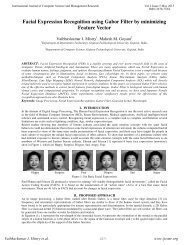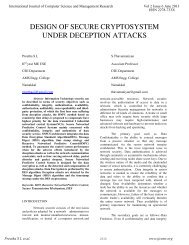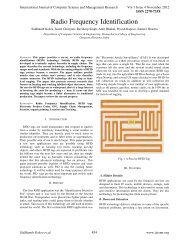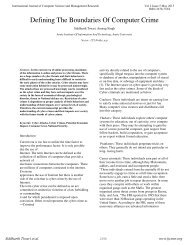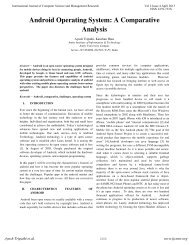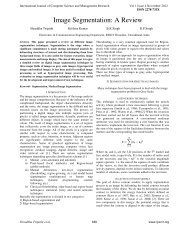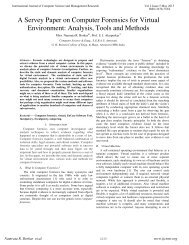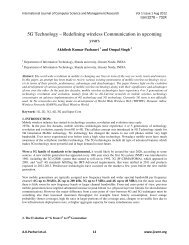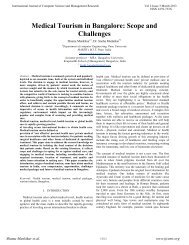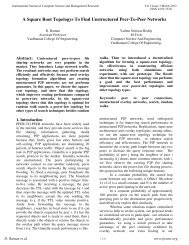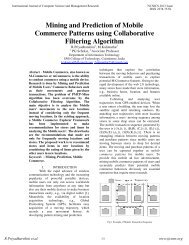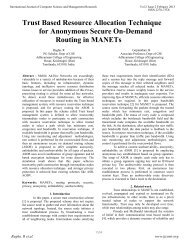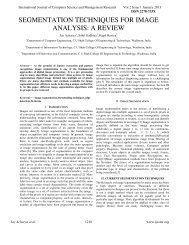A Survey on Seeded Region Growing based Segmentation ... - ijcsmr
A Survey on Seeded Region Growing based Segmentation ... - ijcsmr
A Survey on Seeded Region Growing based Segmentation ... - ijcsmr
You also want an ePaper? Increase the reach of your titles
YUMPU automatically turns print PDFs into web optimized ePapers that Google loves.
Internati<strong>on</strong>al Journal of Computer Science and Management Research Vol 2 Issue 6 June 2013<br />
ISSN 2278-733X<br />
match, they are merged into a larger regi<strong>on</strong> and a new regi<strong>on</strong><br />
descripti<strong>on</strong> is computed. Otherwise regi<strong>on</strong>s are marked as<br />
n<strong>on</strong>-matching. Merging of adjacent regi<strong>on</strong>s c<strong>on</strong>tinues between<br />
all neighbours, including newly formed <strong>on</strong>es. If a regi<strong>on</strong><br />
cannot be merged with any of its neighbours, it is marked `-<br />
nil' and the merging process stops when all image regi<strong>on</strong>s are<br />
so marked.<br />
In this paper [2] Active C<strong>on</strong>tour Method was proposed. An<br />
active c<strong>on</strong>tour is an energy minimizing spline that detects<br />
species features within an image. It is an edible curve (or<br />
surface) which can be dynamically adapted to required edges<br />
or objects in the image (it can be used to automatic objects<br />
segmentati<strong>on</strong>). It c<strong>on</strong>sists of a set of c<strong>on</strong>trol points c<strong>on</strong>nected<br />
by straight lines. The active c<strong>on</strong>tour is denned by the number<br />
of c<strong>on</strong>trol points as well as sequence of each other. Fitting<br />
active c<strong>on</strong>tours to shapes in images is an interactive process.<br />
The user must suggest an initial c<strong>on</strong>tour, which is quite close<br />
to the intended shape.<br />
The c<strong>on</strong>tour will then be attracted to features in the image<br />
extracted by internal energy creating an attractor image.<br />
Figure 2: Basic c<strong>on</strong>tour formati<strong>on</strong><br />
In paper [10] researchers has implemented Active<br />
c<strong>on</strong>tours, or snakes, have been used widely for image<br />
segment- stati<strong>on</strong>. A novel method incorporating geodesic<br />
curves and regi<strong>on</strong> informati<strong>on</strong> is introduced. The extra regi<strong>on</strong><br />
force gives the active c<strong>on</strong>tour model a global complementary<br />
view of the boundary informati<strong>on</strong> within the image. The<br />
proposed method incorporates edge informati<strong>on</strong>, namely<br />
Edgewood, into Active C<strong>on</strong>tours. We refer to this as<br />
Edgewood-driven Geometric Snake or EDGS. The partial<br />
differential equati<strong>on</strong> (PDE) resulting from this integrati<strong>on</strong> of<br />
image Edgewood and regi<strong>on</strong> term is implemented using a<br />
level set approach. Experimental results dem<strong>on</strong>strate that the<br />
proposed method makes sound results, especially with respect<br />
to images within weak boundaries, and noise.<br />
In this paper [6] researcher propose selecti<strong>on</strong> of seed<br />
points. Seed point selecti<strong>on</strong> is <strong>based</strong> <strong>on</strong> some user criteri<strong>on</strong>.<br />
The initial regi<strong>on</strong> begins as the exact locati<strong>on</strong> of these seeds.<br />
The regi<strong>on</strong>s are then grown from these seed points to adjacent<br />
points depending <strong>on</strong> a regi<strong>on</strong> membership criteri<strong>on</strong>. The<br />
criteri<strong>on</strong> could be, for example, pixel intensity, gravy level<br />
texture, or colour. Since the regi<strong>on</strong>s are grown <strong>on</strong> the basis of<br />
the criteri<strong>on</strong>, the image informati<strong>on</strong> itself is important. For<br />
example, if the criteri<strong>on</strong> were a pixel intensity threshold value,<br />
knowledge of the histogram of the image would be of use, as<br />
<strong>on</strong>e could use it to determine a suitable threshold value for the<br />
regi<strong>on</strong> membership criteri<strong>on</strong>.<br />
In this paper L et. al [5] Seed <strong>Growing</strong> method is<br />
discussed. Segmentati<strong>on</strong> of medical images using seeded<br />
regi<strong>on</strong> growing technique is increasingly becoming a popular<br />
method because of its ability to involve high-level knowledge<br />
of anatomical structures in seed selecti<strong>on</strong> process. Regi<strong>on</strong><br />
<strong>based</strong> segmentati<strong>on</strong> of medical images are widely used in<br />
varied clinical applicati<strong>on</strong>s like visualizati<strong>on</strong>, b<strong>on</strong>e detecti<strong>on</strong>,<br />
tumour detecti<strong>on</strong> and unsupervised image retrieval in clinical<br />
databases.<br />
As medical images are mostly fuzzy in nature, segmenting<br />
regi<strong>on</strong>s <strong>based</strong> intensity is the most challenging task. In this<br />
paper, authors has discussed about popular seeded regi<strong>on</strong><br />
grow methodology used for segmenting anatomical structures<br />
in images. Researchers have proposed a gradient <strong>based</strong><br />
homogeneity criteria to c<strong>on</strong>trol the regi<strong>on</strong> grow process while<br />
segmenting images. <strong>Seeded</strong> regi<strong>on</strong> growing approach to image<br />
segmentati<strong>on</strong> is to segment an image into regi<strong>on</strong>s with respect<br />
to a set of q seeds as presented in is discussed here. Given the<br />
set of seeds, S1, S2, Sq., each step of SRG involves<br />
identifying <strong>on</strong>e additi<strong>on</strong>al pixel to <strong>on</strong>e of the seed sets.<br />
Moreover, these initial seeds are further replaced by the<br />
centroids of these generated homogeneous 8 regi<strong>on</strong>s. The <strong>on</strong>ly<br />
drawback of SRG algorithm is the docility in automating seed<br />
generati<strong>on</strong> and dependency of output <strong>on</strong> order sorting of pixel<br />
as deferent order of processing pixels during regi<strong>on</strong> grow<br />
process leads to deferent final segmentati<strong>on</strong> results.<br />
In this paper researcher [4] proposed that Segmentati<strong>on</strong> of<br />
ultrasound images is a midcult task, due to numerous artefacts<br />
and the presence of speckled noise. Dentiti<strong>on</strong>s between<br />
objects are often blurred and weakened by speckling.<br />
C<strong>on</strong>sequently, segmentati<strong>on</strong> methods for ultrasound must be<br />
resistant to noise. In this paper, a method called <strong>Seeded</strong><br />
Regi<strong>on</strong> <strong>Growing</strong> (SRG) is tested in isolating regi<strong>on</strong>s of<br />
interest for later processing.<br />
The SRG method involves selecting points called seeds as<br />
the starting locati<strong>on</strong>s for the segmentati<strong>on</strong> process. Seed<br />
points may be manually or automatically selected, and both<br />
methods of seed selecti<strong>on</strong> are tested and compared. The<br />
Savneet Dhaliwal et.al.<br />
2816<br />
www.<strong>ijcsmr</strong>.org




